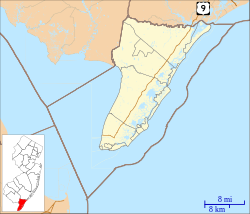Saint Peter's-By-The-Sea Episcopal Church | |
 | |
| Location | Jct. of Ocean Avenue and Lake Drive, Cape May Point, New Jersey |
|---|---|
| Coordinates | 38°56′3″N74°58′0″W / 38.93417°N 74.96667°W |
| Area | less than one acre |
| Built | 1876 |
| Architectural style | Stick/Eastlake |
| NRHP reference No. | 95000978 [1] |
| NJRHP No. | 2804 [2] |
| Significant dates | |
| Added to NRHP | August 3, 1995 |
| Designated NJRHP | June 15, 1995 |
Saint Peter's-By-The-Sea Episcopal Church, known locally as The Gingerbread Church, [3] is a historic church located at the junction of Ocean Avenue and Lake Drive in Cape May Point, Cape May County, New Jersey, United States. It was documented by the Historic American Buildings Survey in 1992. [4] It was later added to the National Register of Historic Places on August 3, 1995 for its significance in Stick/Eastlake architecture and also community planning and development. [5]




